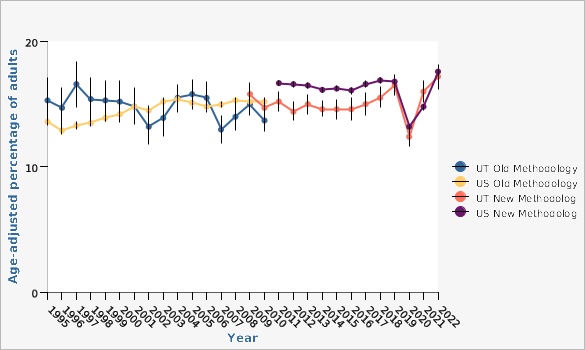Why Is This Important?
General physical health status is the culmination of all the things that affect a person's health. A person may have had poor health because of an injury, an acute infection such as a cold or flu, or a chronic health problem. This measure can be used to identify health disparities, track population trends, plan public health programs, and measure progress toward several Healthy People 2030 goals.Seven or more days of poor physical health in the past 30 days, Utah and U.S., 1995-2022 |
Data Sources
- Utah Department of Health and Human Services Behavioral Risk Factor Surveillance System (BRFSS) [https://ibis.health.utah.gov/ibisph-view/query/selection/brfss/BRFSSSelection.html]
- Behavioral Risk Factor Surveillance System Survey Data, US Department of Health and Human Services Centers for Disease Control and Prevention (CDC).
Data Notes
Age adjusted to U.S. 2000 standard population.
^ In 2002, only Utah and 22 other states asked the question.
U.S. data are the average for all states and the District of Columbia; they do not include the U.S. territories.
Note: At the time of this update, the BRFSS U.S. dataset did not include an age variable but did include five age categories up to age 80+ (vs. the typical weighting scheme that includes 85+). Comparisons with both weighting schemes were compared using Utah data, and the difference was about 1/100 of a percentage point.
Starting in 2009, the BRFSS included both landline and cell phone respondent interviews along with a new weighting methodology called iterative proportional fitting, or raking. More details about these changes can be found at: [https://ibis.health.utah.gov/pdf/opha/resource/brfss/RakingImpact2011.pdf].Risk Factors
Poor health status is related to many of the risk factors for disease and injury such as overweight/obesity, physical inactivity, smoking, and lack of immunization.How Are We Doing?
In 2022, an estimated 17.2% (age-adjusted rate) of Utah adults reported seven or more days in the past 30 days when their physical health was not good. Adults who were obese reported seven or more days of poor physical health at higher rates (22.5%) than their normal weight (14.7%) or overweight (14.9%) counterparts (age-adjusted rates). Current smokers also reported higher rates of poor physical health (24.7%) in the past 30 days than nonsmokers (16.9%) (age-adjusted rates).What Is Being Done?
Until the last few years efforts to control chronic diseases have focused on preventing premature mortality. Reducing morbidity and improving disease self-management skills are now receiving considerably more attention from chronic disease prevention and control programs. The goal is to decrease the percentage of adults, including those who may have a chronic condition, who experience poor physical health days.
Date Indicator Content Last Updated: 03/07/2024
Other Views
- by sex and age group, Utah, 2022
- by education level, Utah, 2022
- by income category, Utah, 2022
- by ethnicity, Utah, 2022
- by race, Utah, 2020-2022 and U.S. 2022
- by weight category, Utah, 2022
- by current smoker status, Utah, 2022
- by local health district, Utah, 2022
- by Utah Small Area, 2020-2022 and U.S. 2022
- Utah and U.S., 1995-2022

